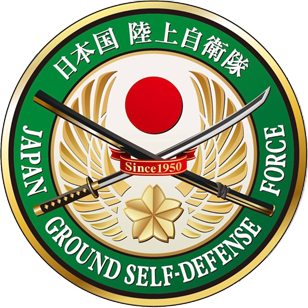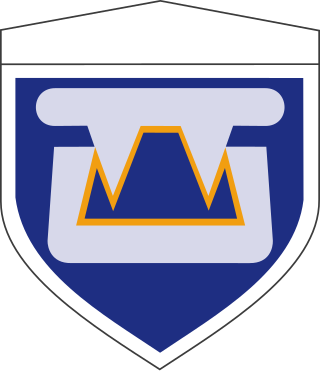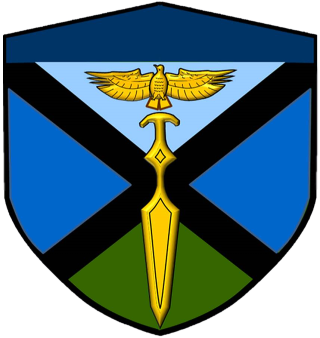Related Research Articles

The Djibouti Armed Forces are the military forces of Djibouti. They consist of the Djiboutian National Army and its sub-branches the Djiboutian Air Force and Djiboutian Navy. As of 2018, the Djibouti Armed Forces consists of 20,470 ground troops, which are divided into several regiments and battalions garrisoned in various areas throughout the country. The Djibouti Armed Forces are an important player in the Bab-el-Mandeb and Red Sea.

The Slovenian Armed Forces or Slovenian Army are the armed forces of Slovenia. Since 2003, it is organized as a fully professional standing army. The Commander-in-Chief of the SAF is the President of the Republic of Slovenia, while operational command is in the domain of the Chief of the General Staff of the Slovenian Armed Forces.

The Sudanese Armed Forces are the military forces of the Republic of the Sudan. In 2011, IISS estimated the forces' numbers at 109,300 personnel. In 2022-23 CIA estimated the armed forces to number 100-125,000.

The British Armed Forces, formally known as His Majesty's Armed Forces, are the military forces responsible for the defence of the United Kingdom, its Overseas Territories and the Crown Dependencies. They also promote the UK's wider interests, support international peacekeeping efforts and provide humanitarian aid.

The People's Army of Vietnam, officially the Vietnam People's Army (VPA), also less formally recognized as the Vietnamese Army or the People's Army, is the military force of the Socialist Republic of Vietnam and the armed wing of the ruling Communist Party of Vietnam (CPV). The PAVN is a part of the Vietnam People's Armed Forces and includes: Ground Force, Navy, Air Force, Border Guard and Coast Guard. Vietnam does not have a separate Ground Force or Army service. All ground troops, army corps, military districts and special forces belong to the Ministry of National Defence, directly under the command of the CPV Central Military Commission, the Minister of National Defence, and the General Staff of the Vietnam People's Army. The military flag of the PAVN is the National flag of the Socialist Republic of Vietnam defaced with the motto Quyết thắng added in yellow at the top left.

The 8 inch (203 mm) M110 self-propelled howitzer is an American self-propelled artillery system consisting of an M115 203 mm howitzer installed on a purpose-built chassis. Before its retirement from US service, it was the largest available self-propelled howitzer in the United States Army's inventory; it continues in service with the armed forces of other countries, to which it was exported. Missions include general support, counter-battery fire, and suppression of enemy air defense systems.

The Indian Army is the land-based branch and largest component of the Indian Armed Forces. The President of India is the Supreme Commander of the Indian Army, and its professional head is the Chief of Army Staff (COAS). The Indian Army was established on 1 April 1895 alongside the long established presidency armies of the East India Company, which too were absorbed into it in 1903. Some princely states maintained their own armies which formed the Imperial Service Troops which, along with the Indian Army formed the land component of the Armed Forces of the Crown of India, responsible for the defence of the Indian Empire. The Imperial Service Troops were merged into the Indian Army after independence. The units and regiments of the Indian Army have diverse histories and have participated in several battles and campaigns around the world, earning many battle and theatre honours before and after Independence.

Power projection in international relations is the capacity of a state to deploy and sustain forces outside its territory. The ability of a state to project its power into an area may serve as an effective diplomatic lever, influencing the decision-making processes and acting as a potential deterrent on other states' behavior.

The Republic of China Army (ROCA), also known unofficially as the Taiwanese Army, is the largest branch of the Republic of China Armed Forces. An estimated 80% of the ROC Army is located on Taiwan, while the remainder are stationed on the Penghu, Kinmen, Matsu, Dongsha and Taiping Islands.

The M777 howitzer is a British towed 155 mm artillery piece in the howitzer class. It is used by the ground forces of Australia, Canada, Colombia, India, Saudi Arabia, Ukraine, and the United States. It was first used in combat during the War in Afghanistan.

The JapanSelf-Defense Forces (JSDF), also known as the Japanese Armed Forces, are the unified military forces of Japan. Established in 1954, the JSDF comprises the Japan Ground Self-Defense Force, the Japan Maritime Self-Defense Force, and the Japan Air Self-Defense Force. They are controlled by the Ministry of Defense with the Prime Minister as commander-in-chief.

The Japan Ground Self-Defense Force, JGSDF, also referred to as the Japanese Army, is the land warfare branch of the Japan Self-Defense Forces. Created on July 1, 1954, it is the largest of the three service branches.

The Camion Équipé d'un Système d'Artillerie or CAESAR is a French 155 mm, 52-caliber self-propelled howitzer that can fire 39/52 caliber NATO-standard shells. It is installed on a 6x6 or 8x8 truck chassis. Equipped with an autonomous weapon network incorporating an inertial navigation system and ballistic computer, the CAESAR can accurately strike targets more than 40 kilometres (25 mi) away using "Extended Range, Full Bore" (ERFB) ammunition with base bleed, or targets over 55 kilometres (34 mi) away using rocket assisted or smart ammunition.

The Royal Moroccan Army is the branch of the Royal Moroccan Armed Forces responsible for land-based military operations.
The national security of China is the coordination of a variety of organizations, including law enforcement, military, paramilitary, governmental, and intelligence agencies that aim to ensure China's national security. China considers three factors in its national security: national sovereignty, security, and development interests.

The Western Army (西部方面隊) is one of five active Armies of the Japan Ground Self-Defense Force. It is headquartered in Kumamoto, Kumamoto Prefecture. Its responsibility is the defense of Kyūshū and Okinawa.
Military exercises are conducted by the Pakistan Armed Forces to increase combat readiness, and to identify problems in logistics, training, and current military doctrine. They also test the ability of units to work together. Lastly, they act as a visible expression of military might, which acts as a deterrent to potential enemy action. An important component of each exercise is the after-action assessment. Since 1989 the four branches services have increasingly begun coordinated exercises.
Enhanced Forward Presence (EFP) is a NATO-allied forward-deployed defense and deterrence military force in Northern, Central and Eastern Europe. This posture in Northern Europe through Estonia, Latvia, and Lithuania and in Central Europe through Poland, Slovakia and Hungary and in Eastern Europe through Romania and Bulgaria, is in place to protect and reassure the security of NATO's Northern, Central and Eastern European member states on NATO's eastern flank.

The Amphibious Rapid Deployment Brigade is a marine unit of the Japan Self-Defense Forces (JSDF) responsible for conducting amphibious operations.
A Reciprocal Access Agreement (RAA) (ja: 部隊間協力円滑化協定, Force-to-force Cooperation Facilitation Agreement) refers to a bilateral defense and security pacts between Japan and governments that provides shared military training and military operations. It is an agreement built to create a framework for the two cooperating countries to move their military force whenever required, and also provides a pathway for goods to be imported and exported from one country to the other through following the movement of visiting military forces.
References
- 1 2 "Going big in Japan". army.mod. British Army. 2 December 2022. Retrieved 15 July 2023.
- ↑ "Bilateral Field Training Exercise by the Japan Ground Self-Defense Force (JGSDF) and the British Army "VIGILANT ISLES 22"". japan.go,jp. Government of Japan. 4 November 2022. Retrieved 15 July 2023.
- ↑ McNary, Dave (30 November 2022). "Japan and UK warn of 'sharp destabilisation' in security environment". Financial Times.
- ↑ McNary, Dave (11 January 2023). "UK, Japan ink agreement to enable bilateral troop deployments". DefenseNews.